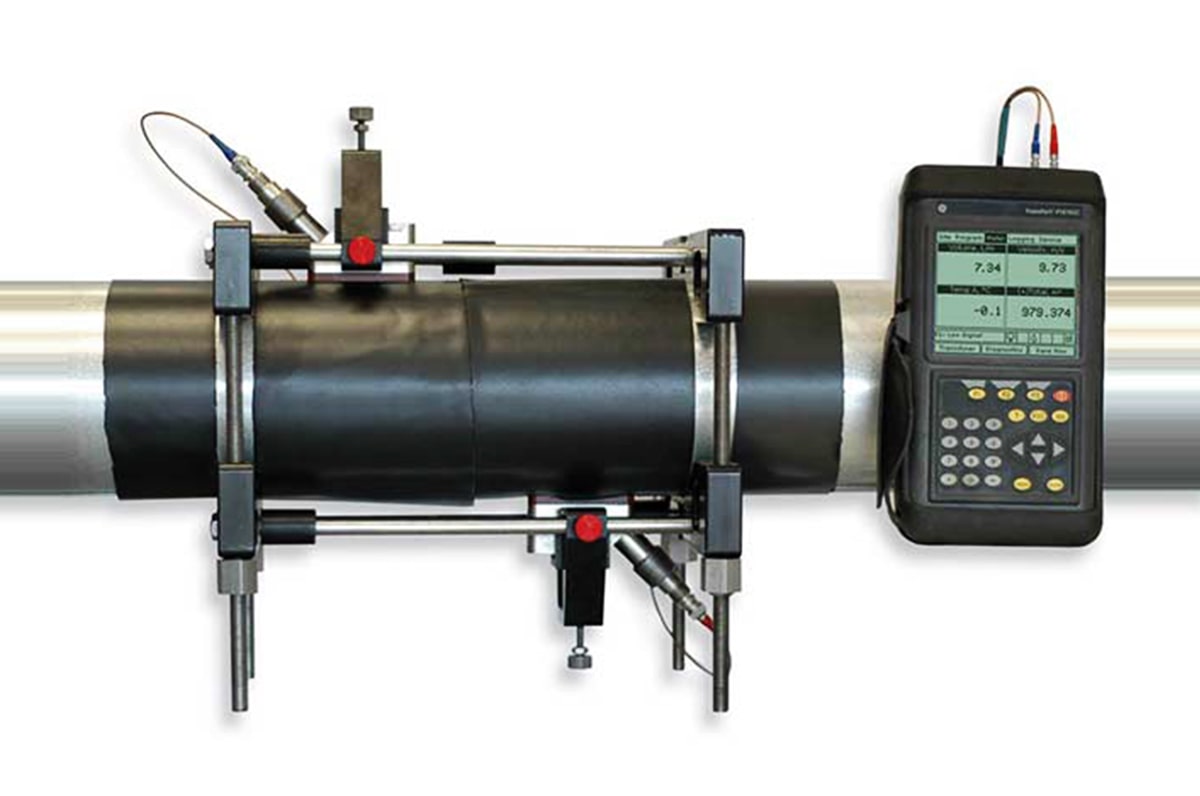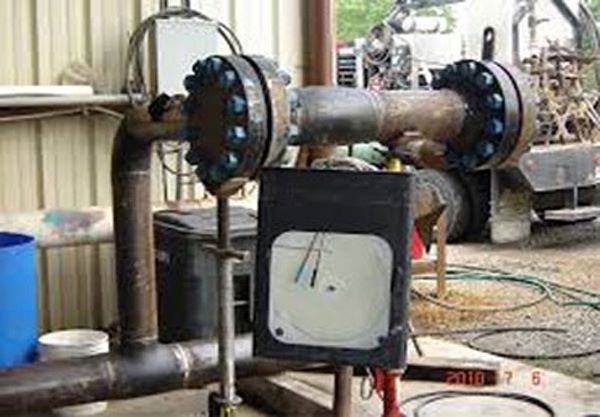
Onsite Flow Survey, Flow Verification, or Flow Calibration Service Overview
Ultrasonic Flow Meters
• Doppler meters measure frequency shifts caused by liquid flow.
• Two transducers are mounted on one side of the pipe.
• A signal of known frequency is sent into the liquid to be measured.
• The frequency shift is proportional to the liquid's velocity.
• A portable Doppler meter has recently been developed for use on AC power or from a rechargeable power pack.
Time-of-Travel Meters
• Time-of-travel meters have transducers mounted on each side of the pipe.
• The speed of the signal travel between the transducers increases or decreases with the direction of transmission and the velocity of the liquid being measured.
• A time-differential relationship proportional to the flow can be obtained by transmitting the signal alternately in both directions.
• The liquids being measured must be relatively free of entrained gas or solids to minimize signal scattering and absorption.
Understanding a Flow Meter
• A flow meter is an instrument used to indicate the amount of liquid, gas, or vapor moving through a pipe or conduit.
• Choosing a flow meter should consider intangible factors such as familiarity of plant personnel, experience with maintenance, spare parts availability, and time between failure history.
Types and Uses of Flow Meters
• Differential pressure flow meters are the most common units in use today.
• They calculate fluid flow by reading pressure loss across a pipe restriction.
• The primary element causes a change in kinetic energy, creating the differential pressure in the pipe.
• The secondary element measures the differential pressure and provides the signal or read-out that is converted to the actual flow value.
Orifice Flow Meters Overview
• Orifice flow meters are popular liquid flow meters with no moving parts and low cost.
• They are installed in pipes between two flanges, constricting liquid flow to produce differential pressure.
• Conical and quadrant orifices are relatively new and designed to measure liquids with low Reynolds numbers.
• Segmental wedge is a restriction orifice designed to measure flow of liquids containing solids.
• Integral wedge assemblies combine the wedge element and pressure taps into a one-piece pipe coupling.
• The accuracy of all orifice flowmeters depends on installation conditions, orifice area ratio, and the physical properties of the liquid being measured.
Venturi Flow Meters
• Venturi tubes handle large flow volumes at low pressure drops.
• They have no moving parts and can be installed in large diameter pipes using flanged, welded, or threaded-end fittings.
• They can be used with most liquids, including those with high solids content.
Pitot Tube Flow Meter
• Installed by welding a coupling on a pipe and inserting the probe through the coupling.
• They are susceptible to plugging by foreign material in the liquid.
• Advantages of pitot tubes include low cost, absence of moving parts, easy installation, and minimum pressure drop.
Positive Displacement Flow Meters Overview
• Operates by separating liquids into accurately measured increments and moving them on.
• Popular for automatic batching and accounting applications.
• Good candidates for measuring flows of viscous liquids or for use where a simple mechanical meter system is needed.
Reciprocating Piston Meters
• Single and multiple-piston types.
• Can handle a wide variety of liquids.
• Operates on magnetic drive principle.
• Oval-gear meters have two rotating, oval-shaped gears with synchronized, close fitting teeth.
• Nutating-disk meters have a moveable disk mounted on a concentric sphere located in a spherical side-walled chamber.
• Each cycle is proportional to a specific quantity of flow.
Volumetric Flow Meters
• Operates linearly with respect to the volume flow rate.
• Have minimum sensitivity to viscosity changes when used at Reynolds numbers above 10,000.
• Most velocity-type meter housings are equipped with flanges or fittings to permit them to be connected directly into pipelines.
Turbine Flow Meters
• Widely used for accurate liquid measurement applications.
• Consists of a multiple-bladed rotor mounted with a pipe, perpendicular to the liquid flow.
• The number of electrical pulses counted for a given period of time is directly proportional to flow volume.
Vortex Flow Meters
• Uses a natural phenomenon that occurs when a liquid flows around a bluff object.
• The frequency of the vortex shedding is directly proportional to the velocity of the liquid flowing through the meter.
Magnetic meter
• Can handle most liquids and slurries, provided that the material being metered is electrically conductive.
• Operates on Faraday's law of electromagnetic induction.
• Major advantages include measuring difficult and corrosive liquids and slurries; and measuring forward as well as reverse flow with equal accuracy.




